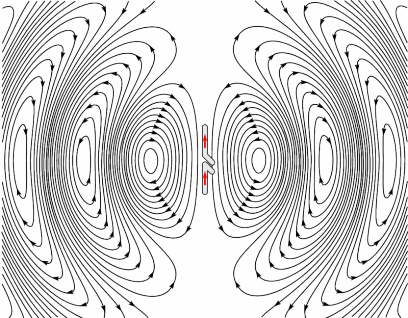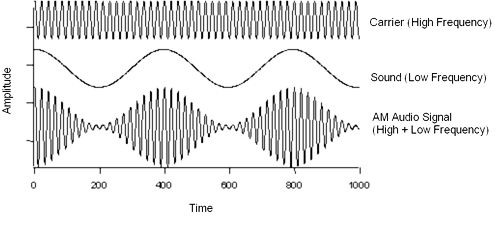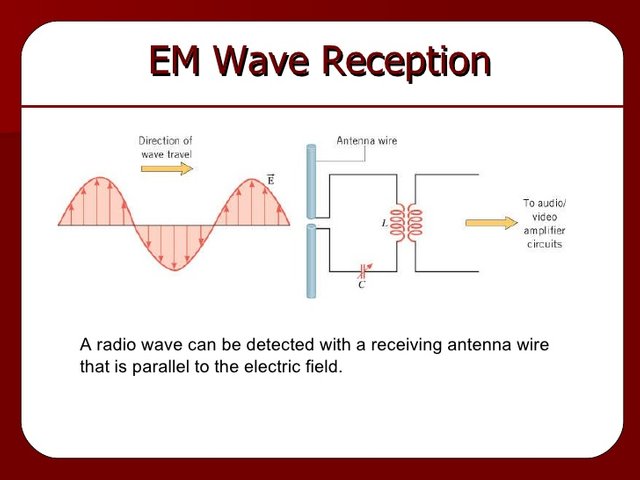Introduction:
An electric charge is capable of producing an electric and magnetic field. Our problem is to know the conditions where these fields would radiate away from the source from which they originate.
Electric charge at rest give rise to a coulomb field i.e an electric field around the charge which is stationary in space: a charge moving with constant speed is equivalent to a steady electric current which generates a magnetic field in the surrounding space. These fields also do not radiate. Hence we should expect radiations only when the charge has accelerated motion. When we accelerate the charge, we do some work and thereby supply the energy which can propagate out in space in form of electromagnetic waves. Thus we know the conditions that an accelerated charge radiates energy.
Production of EM waves ( radio waves):
For the production of electromagnetic waves a radio transmitting antenna provides a good example. The piece of wire along which charges are made to accelerate is known as transmitting antenna. It is connected with an alternating source of potential of frequency f and time period T. As the charging potential alternates, the charge on the antenna;also constantly reverses. For example if the top has +q charge at any instant, then after time T/2 the charge on it will be -q. Such regular reversal of charge on the antenna give rise to an electric flux that constantly changes with frequency f. This changing electric flux sets up an electromagnetic wave which propagates out in space away from antenna. The frequency with which the field alternates is always equals to frequency of the source generating them. These electromagnetic waves which are propagated out in space from antenna of a transmitter are known as radio waves. In free space these waves travel with speed of light.
 )
)
Information carried by EM waves:
It is common experience that sound waves (20Hz to 20kHz) in air can be heard only over short distances.When long distance communication is needed and the free space is a communication channel, antennas radiate and they receive the signal. It is noted here that antennas operates effectively only when their dimensions are of the order of magnitude of the wavelength of the signal being transmitted.
Example
An audio tone of 3kHz when converted into its electrical analog corresponds to a wavelength of (3 x10 8ms-1/3000 Hz) 105m , which is certainly an impracticalable length of an antenna required for the transmission and reception of a tone of 3kHz. The required practical length of the antenna may be obtained by translating the electrical analog of the audio tone to a higher frequency.

Another Example
In the foregoing paragraph the transmission of an audio tone, problem regarding the practicability of the antenna and the possible solution was discussed. Now let's discuss another problem whose solution once again needs frequency translating or shifting.
Suppose we generate an audio signal which has a range. Suppose the audio range extends from 20 Hz to 10kHz .The ratio of the highest audio frequency to the lowest is 500, therefore the antenna designed for one end of the range would be entirely too short or too long for the other end. Once again we can overcome this problem by translating or shifting the audio signal to a higher frequency. For example, the audio signal is translated to a higher frequency of 106Hz. The range occupied is from (20 Hz + 106Hz) to ( 10kHz + 106Hz) yielding a ratio of 1.Therefore translation of an audio signal allows the use of same antenna for both the lowest frequency and the highest frequency of the radio signal. Thus transmission of intelligence ( I.e voice,music code)is accomplished by translating the electrical analog corresponding to the intelligence signal with a high frequency( radio wave) having constant amplitude and fixed frequency generated locally by the transmitting equipments. The process of combining audio frequency (AF) and radio frequency(RF) waves to accomplish translation is called modulation.
Reception of EM waves:

Suppose these waves impinge on the wire. The electrons in the wire move under the action of oscillating electric field which give rise to an alternating voltage across the wire . The frequency of this voltage is the same as that of the wave intercepting the wire. This wire receiving the wave is known as receiving antenna.As the electric field of the wave at a distance of many kilometers from the transmitter, the voltage that appears across receiving antenna is very small. Each transmitter propagates radio waves of one particular frequency.Credit
So when a number of transmitting stations operates simultaneously, we have a number of radio waves of different frequencies. The voltage of one particular frequency can be picked up by connecting an inductance L and a variable capacitor C in parallel with one end of the receiving antenna.If one adjust the value of the capacitor so that the natural frequency of L-C circuit is the same as that of the transmitting station to be picked up, the circuit will resonate under then driving action of the antenna. Consequently the L-C circuit will build up a large response to the action of only that radio wave to which is tuned. In your radio reciever set when you change stations you actually adjust the value of C.References:
http://www.freepatentsonline.com/2283935.html
https://encyclopedia2.thefreedictionary.com/Radio+Waves%2C+Radiation+and+Reception+of
@originalworks
Downvoting a post can decrease pending rewards and make it less visible. Common reasons:
Submit
The @OriginalWorks bot has determined this post by @shehzad to be original material and upvoted(1.5%) it!
To call @OriginalWorks, simply reply to any post with @originalworks or !originalworks in your message!
Downvoting a post can decrease pending rewards and make it less visible. Common reasons:
Submit